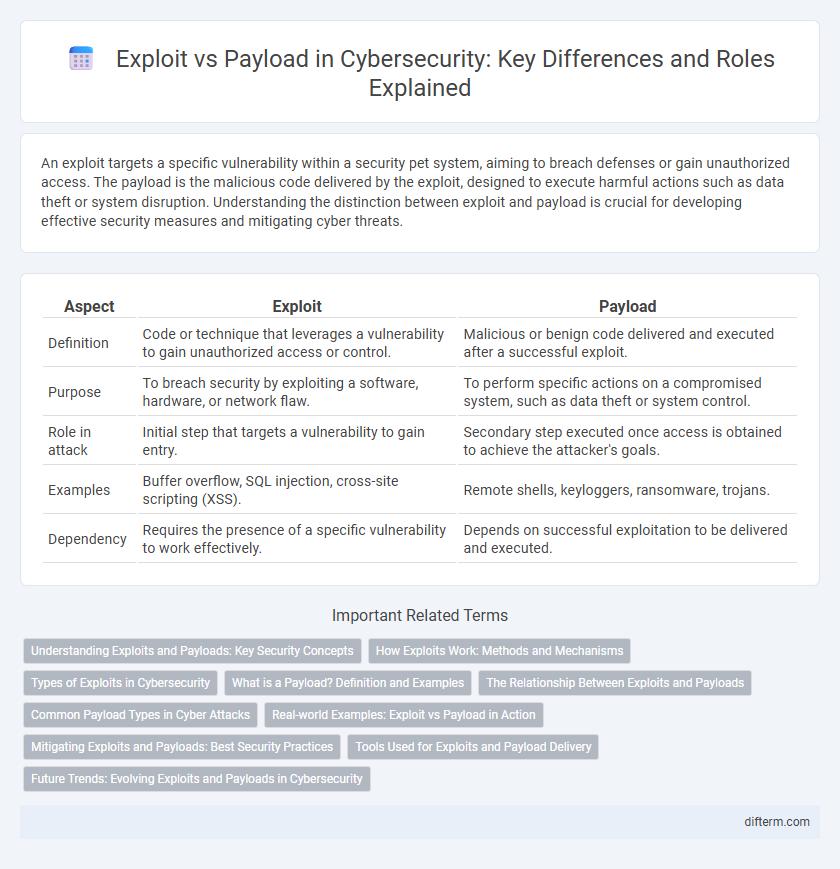An exploit targets a specific vulnerability within a security pet system, aiming to breach defenses or gain unauthorized access. The payload is the malicious code delivered by the exploit, designed to execute harmful actions such as data theft or system disruption. Understanding the distinction between exploit and payload is crucial for developing effective security measures and mitigating cyber threats.
Table of Comparison
| Aspect | Exploit | Payload |
|---|---|---|
| Definition | Code or technique that leverages a vulnerability to gain unauthorized access or control. | Malicious or benign code delivered and executed after a successful exploit. |
| Purpose | To breach security by exploiting a software, hardware, or network flaw. | To perform specific actions on a compromised system, such as data theft or system control. |
| Role in attack | Initial step that targets a vulnerability to gain entry. | Secondary step executed once access is obtained to achieve the attacker's goals. |
| Examples | Buffer overflow, SQL injection, cross-site scripting (XSS). | Remote shells, keyloggers, ransomware, trojans. |
| Dependency | Requires the presence of a specific vulnerability to work effectively. | Depends on successful exploitation to be delivered and executed. |
Understanding Exploits and Payloads: Key Security Concepts
Exploits are techniques or codes that leverage vulnerabilities in software to gain unauthorized access or control. Payloads are the actual malicious components delivered by exploits to execute actions such as data theft, privilege escalation, or system damage. Understanding the distinction between exploits and payloads is crucial for developing effective cybersecurity defenses and threat detection strategies.
How Exploits Work: Methods and Mechanisms
Exploits leverage vulnerabilities in software or hardware by manipulating input, memory management, or authentication processes to gain unauthorized access or control. Common methods include buffer overflow attacks, code injection, and privilege escalation, each exploiting specific security flaws to execute malicious payloads. These mechanisms enable attackers to bypass security controls, inject executable code, or alter system behavior to achieve their objectives.
Types of Exploits in Cybersecurity
Types of exploits in cybersecurity include buffer overflow, remote code execution, privilege escalation, and SQL injection, each targeting specific vulnerabilities to compromise systems. Buffer overflow exploits manipulate memory to execute arbitrary code, while remote code execution allows attackers to run malicious programs remotely. Privilege escalation exploits grant unauthorized higher-level access, and SQL injection targets database vulnerabilities to extract or alter sensitive information.
What is a Payload? Definition and Examples
A payload in cybersecurity refers to the part of malware or an exploit that performs the actual harmful action on a targeted system, such as executing code, stealing data, or creating backdoors. Examples of payloads include ransomware that encrypts files, spyware that captures keystrokes, and rootkits that provide persistent access. Understanding payloads is critical for developing effective defense mechanisms against cyberattacks.
The Relationship Between Exploits and Payloads
Exploits serve as the attack vector that takes advantage of vulnerabilities in software or systems, enabling unauthorized access or control. Payloads are the malicious code or commands delivered through exploits, designed to perform specific actions such as data exfiltration, privilege escalation, or system manipulation. The relationship between exploits and payloads is integral, as exploits function as delivery mechanisms while payloads execute the attacker's intended objectives within the compromised environment.
Common Payload Types in Cyber Attacks
Common payload types in cyber attacks include remote access trojans (RATs), keyloggers, ransomware, and data exfiltration tools, each designed to achieve specific malicious objectives after exploitation. Exploits are the methods used to breach systems, while payloads deliver the actual harm, such as encrypting files or capturing sensitive information. Understanding the payload's function enables more effective detection and mitigation of cyber threats across networks and endpoints.
Real-world Examples: Exploit vs Payload in Action
Real-world examples highlight the distinction between exploits and payloads in cybersecurity incidents. The EternalBlue exploit targeted a vulnerability in Microsoft's SMB protocol to gain unauthorized access, while the WannaCry ransomware payload encrypted victims' data after successful exploitation. Understanding this interaction helps security professionals develop effective defenses by addressing both the exploit mechanisms and payload delivery.
Mitigating Exploits and Payloads: Best Security Practices
Mitigating exploits and payloads requires implementing layered security measures such as regular patch management to address software vulnerabilities and employing endpoint detection and response (EDR) tools to identify and block malicious payloads. Network segmentation and application whitelisting reduce the attack surface by limiting exploit opportunities and preventing unauthorized code execution. Continuous monitoring, threat intelligence integration, and user education on social engineering further strengthen defenses against both exploit delivery and malicious payload activation.
Tools Used for Exploits and Payload Delivery
Exploit tools such as Metasploit Framework and Core Impact specialize in identifying and leveraging vulnerabilities in target systems to execute unauthorized code. Payload delivery mechanisms like Veil-Evasion and Empire are designed to deploy malicious code while evading detection by antivirus and intrusion prevention systems. Together, these tools form an integrated approach to penetration testing and red team operations, enhancing the ability to simulate real-world cyberattacks effectively.
Future Trends: Evolving Exploits and Payloads in Cybersecurity
Future trends in cybersecurity indicate a rise in sophisticated exploits leveraging artificial intelligence and machine learning to bypass traditional defenses. Payloads are evolving to include multifunctional capabilities such as stealthy data exfiltration, ransomware deployment, and autonomous lateral movement within networks. Increasing use of polymorphic and fileless malware demonstrates a shift toward highly adaptive attack vectors challenging existing detection and mitigation strategies.
Exploit vs Payload Infographic

 difterm.com
difterm.com